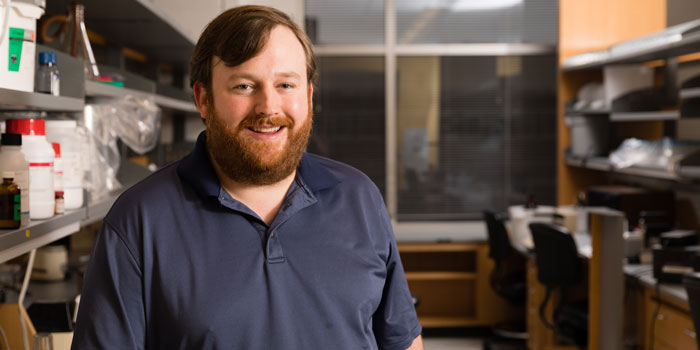CBS faculty member Aaron Engelhart has some big plans for some of biology's most versatile molecules.

Introductory organic chemistry has sent many a pre-med scurrying toward an alternative career. And that’s exactly what it did for Aaron Engelhart — but not for the usual reason, and not in the usual direction. Instead of steering him away from science, the class steered him toward it, and he gave up his ambitions to be a doctor to pursue a Ph.D. in molecular biology.
“It was a completely different way of looking at the world,” says Engelhart, who joined the Department of Genetics, Cell Biology, and Development (GCD) as an assistant professor last summer. “The fact that you could read an ingredient label and have a picture of what stuff is in it — a shampoo bottle made sense in a way it never had before. And then just generally the idea of organic synthesis, that you can transform molecules like Legos and you can mix and match atoms. It was really interesting.”
Even as an undergrad, Engelhart was particularly fascinated by one class of molecule: nucleic acids. These molecules are best known for their ability to carry information in the form of DNA and RNA. But, Engelhart says, that’s just part of the story. Nucleic acids can also act as enzymes, making it easier for other molecules to combine or split up, or as receptors, connecting with other molecules to create a cascade of change within a living system. They can be modified in a variety of ways that can give them useful traits, such as the ability to be anchored in membranes. And short chunks of nucleic acids known as aptamers can be used to hold and transport specific molecules.
It’s this capacity in particular that captured Engelhart’s attention and imagination. Various aptamers have been developed to bind specifically to everything from neurotransmitters to cells and used for purposes that range from diagnosing disease to discovering new drugs.
“It’s proven to be this tremendously powerful technique where you can more or less take an arbitrary target from things as simple as a small molecule to something like a drug all the way up to specific cells and you can have them bind to a really broad range of targets,” he says. Not only that, but because nucleic acids are masters of replication, it’s a breeze to make large quantities of an aptamer of choice.
In one line of research, Engelhart is using an RNA aptamer to introduce specific components into artificial cells — part of a larger collaboration with Kate Adamala, also an assistant professor in GCD, and others to try to assemble cell-like systems from inanimate parts. In another, he and Adamala are making use of an aptamer that binds a molecule that glows under certain conditions. By combining this aptamer with another type, they hope to be able to create a tool that lets them, in Engelhart’s words, “eavesdrop on cells communicating with each other.”
As fascinating as these applications are, Engelhart says they’re just the tip of the iceberg as far as nucleic acids go. Scientists have been working with aptamers for more than a quarter century, but there are still many opportunities to envision more applications, develop more robust aptamer-based tools, and apply those tools to new systems, even whole organisms.
Hearing Engelhart talk about his work, it quickly becomes obvious that that early-stage career shift was a wise one. He likes pretty much everything about what he does.
“It’s always something different every day,” he says. “It’s never boring. There’s always something new, there’s always something exciting.” —Mary Hoff